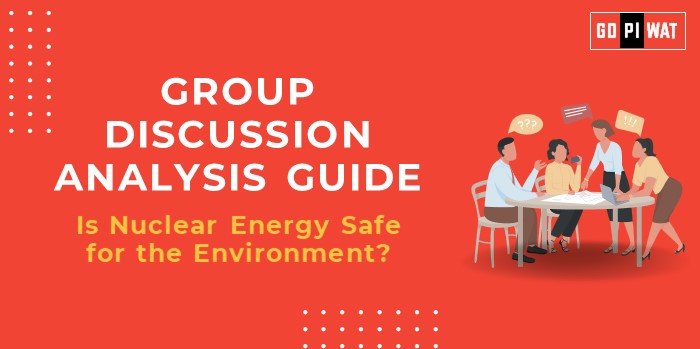📋 Group Discussion Analysis: Is Nuclear Energy Safe for the Environment?
🌐 Introduction
Context Setting: Nuclear energy, recognized for its ability to produce large amounts of electricity with minimal greenhouse gas emissions, remains a controversial topic due to concerns over environmental safety, waste disposal, and nuclear accidents. This topic challenges us to consider nuclear energy’s role in sustainable development amidst global climate goals.
Topic Background: Originating as an energy source in the 1950s, nuclear power has evolved through innovations and stringent safety protocols. However, incidents like Chernobyl and Fukushima have raised public apprehension about environmental risks. Today, 30 countries use nuclear energy, contributing around 10% of global electricity, making it crucial to evaluate its environmental safety.
📊 Quick Facts and Key Statistics
- 🌍 Global Nuclear Power Share: 10% of global electricity in 2023 – Demonstrates nuclear energy’s role in reducing fossil fuel reliance.
- 🟢 Zero Carbon Emissions during Operation: Nuclear plants emit no CO₂ while generating power – Vital in the fight against climate change.
- ⚠️ Nuclear Waste Longevity: Nuclear waste can remain hazardous for up to 10,000 years – Highlights the long-term environmental risk.
- 💥 Accident Impact: Fukushima disaster led to 154,000 people’s displacement and significant ecological damage – Illustrates potential catastrophic consequences.
🤝 Stakeholders and Their Roles
- 🏛️ Governments: Regulate safety protocols and promote or limit nuclear energy based on environmental policy.
- 🏗️ Energy Corporations: Develop and manage nuclear plants, innovate in waste reduction, and improve safety.
- 🌱 Environmental Groups: Monitor and advocate for minimizing risks and promoting alternative renewables.
- 🌐 International Organizations (e.g., IAEA): Set global safety standards and provide monitoring and support for nuclear safety.
✨ Achievements and Challenges
🏆 Achievements
- 🟢 Low Emissions: Nuclear plants generate minimal CO₂ during operation, contributing to cleaner air and helping mitigate climate change.
- 🔋 Energy Efficiency: Nuclear reactors have high capacity factors, making them a reliable, steady energy source.
- 🔒 Advanced Reactor Safety: Newer reactors are designed with enhanced safety mechanisms, reducing accident risks.
⚠️ Challenges
- ♻️ Waste Disposal: Managing radioactive waste safely over millennia is a significant unresolved issue.
- 💥 Risk of Accidents: Despite advancements, nuclear accidents, though rare, can have devastating, long-lasting environmental impacts.
- 🌍 Global Comparison: Countries like France successfully utilize nuclear energy, while Germany is phasing it out in favor of renewable sources due to environmental and safety concerns.
Case Study: France relies on nuclear for around 70% of its electricity, showcasing a stable, low-carbon energy model, contrasting with Germany’s nuclear phase-out policy.
🗣️ Structured Arguments for Discussion
- ✅ Supporting Stance: “Nuclear energy offers a reliable, low-carbon solution that supports climate change goals and energy security.”
- ❌ Opposing Stance: “Nuclear waste and accident risks pose serious environmental threats that cannot be ignored.”
- ⚖️ Balanced Perspective: “While nuclear energy reduces greenhouse gases, its environmental safety depends on effective waste management and stringent safety regulations.”
🛠️ Effective Discussion Approaches
- 📊 Statistical Impact: “With nuclear providing 10% of global electricity, it’s integral in low-emission energy.”
- ⚡ Contrast Approach: “While nuclear is low in carbon emissions, the long-term risk of waste disposal remains problematic.”
- 📖 Case Study Opening: “The Fukushima disaster reminds us of the potential ecological risks tied to nuclear energy.”
💡 Counter-Argument Handling: Respond with data on safety improvements, international standards, or reference to countries like France with a strong nuclear safety record.
🔍 Strategic Analysis of Strengths and Weaknesses
- Strengths: Low carbon emissions, high energy density, reliable energy source.
- Weaknesses: Risk of accidents, long-lived waste, high decommissioning costs.
- Opportunities: Technological advancements in safer reactor designs, potential for reducing fossil fuel dependency.
- Threats: Public opposition, natural disasters affecting plant safety, unresolved waste disposal issues.
🎓 Connecting with B-School Applications
Real-World Applications: Renewable energy policy formulation, energy economics, sustainable development planning.
Sample Interview Questions:
- “How does nuclear energy compare to renewables in terms of environmental safety?”
- “What are the economic impacts of nuclear energy for a developing nation?”
Insights for B-School Students: Consider nuclear energy’s role in achieving net-zero targets, its impact on the energy economy, and technological advancements in reactor safety.


